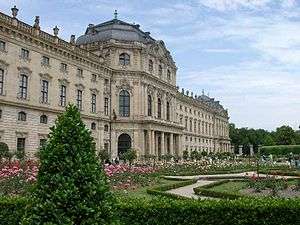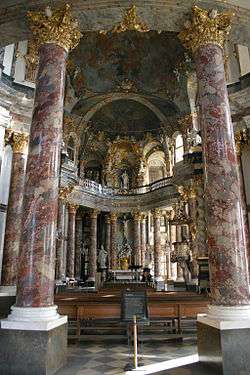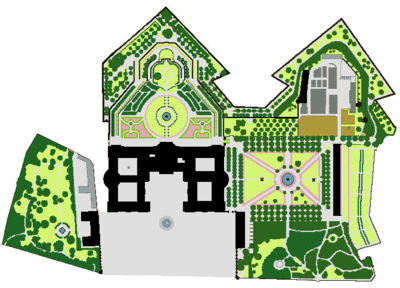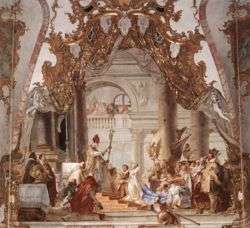Würzburg Residence
| Würzburg Residence with the Court Gardens and Residence Square | |
|---|---|
| Name as inscribed on the World Heritage List | |
 | |
| Type | Cultural |
| Criteria | i, iv |
| Reference | 169 |
| UNESCO region | Europe and North America |
| Inscription history | |
| Inscription | 1981 (5th Session) |
The Würzburg Residence (German: Würzburger Residenz) is a palace in Würzburg, Lower Franconia. Johann Lukas von Hildebrandt and Maximilian von Welsch, representatives of the Austrian/South German Baroque style, were involved in the construction, as well as Robert de Cotte and Germain Boffrand, who were followers of the French Style. Balthasar Neumann, architect of the court of the Bishop of Würzburg, was the principal architect of the Residenz, which was commissioned by the Prince-Bishop of Würzburg Johann Philipp Franz von Schönborn and his brother Friedrich Carl von Schönborn in 1720, and completed in 1744. The Venetian painter Giovanni Battista Tiepolo, assisted by his son, Domenico, painted frescoes in the building.
Interiors include the grand staircase, the chapel, and the grand salon. The building was dubbed the "nicest parsonage in Europe" by Napoleon. It was heavily damaged during World War II, and restoration has been in progress since 1945.
History


18th century
The Prince-Bishops of Würzburg resided in the Marienberg Fortress until the early eighteenth century. Johann Philipp Franz von Schönborn (1719–1724) moved the court to a palace erected in 1701 - 1704, the predecessor of the residence, but the rather small palace did not, in his opinion, measure up to his position as an absolute monarch. Having won a sum of 600,000 fl. (a fortune at the time) in a court case in the year of his accession, he used the funds to undertake a building project that would proclaim his political standing to all.
In this, he was eagerly supported by two relatives, his uncle the Prince-Archbishop and Elector of Mainz, Lothar Franz von Schönborn (who confessed to have been possessed by a "Bauwurm", a building bug) and his brother Friedrich Carl von Schönborn, reformer of the Imperial Chancery in Vienna. Both supplied ideas and, crucially, artists from their circles. The foundation stone was laid on 22 May 1720. The construction started with the north block.
The Prince-Bishop Christoph Franz von Hutten had no great interest in building such an enormous palace. He only wanted the northern block to be finished. This construction was concluded in the year of his death, 1729. All other works were ceased.

In the year 1730, however, under Prince-Bishop Friedrich Carl von Schönborn, work on the south block began once more. In 1732/33, the front of the Cour d'honneur was completed. From 1735 onwards, the work on the central building took place with the participation of Lucas von Hildebrandt. In 1737, the main staircase was constructed. Balthasar Neumann primarily designed two similar main staircases, with another identical staircase on the other side of the vestibule. The garden front was completed in 1740 and the whole shell in December 1744. The completion of the vaulted ceilings over the Emperor's Hall and the White Hall took place in 1742; the vault over the staircase in 1743. At the same time, the decorations of the Court Chapel were realized and its consecration performed in 1743. From 1740 to 1745, the southern Imperial Apartments and the Mirror Cabinet were decorated, while Antonio Bossi created the stucco-work in the White Hall during the years 1744-1745.
Under the rule of Prince-Bishop Anselm Franz von Ingelheim, all building work on the residence ceased once again. After his death, once Karl Philipp von Greifenclau zu Vollraths became Prince-Bishop, he ordered the return to construction. In the same year, Antonio Bossi completed the stucco-work in the Garden Hall, the painting of which was finished in the next year. In 1650 Lorenz Jakob Mehling sent Tiepolo to the bishopric residence, after Giuseppe Visconti had failed.[1] Frescoes by Giovanni Battista Tiepolo, assisted by his sons, decorated the Imperial Hall (1751–52) and the ceiling above the staircase (1752–1753). In 1753, Balthasar Neumann died.
Under Prince-Bishop Adam Friedrich von Seinsheim, from 1769 until 1772, Materno and Ludovico Bossi created the stucco-work decoration over the staircase and in the first and second guest rooms of the northern Imperial Apartments. At the same time, the Green Lacquered Room and the Princes' Hall were finished. From 1776 to 1781, the Ingelheim Rooms were decorated, including stucco-work by Materno Bossi.
Changes in Empire Style
The episcopal principality of Würzburg was abolished with secularization. An eight-year interregnum by Grand Duke Ferdinand of Tuscany (reigned 1806–1814) followed, during which he had several rooms of the south block, the so-called Tuscany Rooms, decorated in neoclassical style. Emperor Napoleon Bonaparte slept in the Residence when he stopped in Würzburg three times between 1806 and 1813. A neoclassical double bed and bedside tables were installed in the sleeping room of the northern Imperial Apartments for him and his wife Marie Louise in 1812.
In 1814, Würzburg became part of the Kingdom of Bavaria. The wrought-iron gates across the Cour d'honneur, which had effectively separated this inner area from the large Residence Square, were demolished in 1821. In their place today is the Franconia Fountain created by Ferdinand von Miller the Younger. This was unveiled in 1894 as a tribute by the city of Würzburg and the whole of Franconia to Prince Regent Luitpold, who was born in 1821 in the Würzburg Residence itself.
Destruction in World War II
As a result of a devastating air raid on March 16, 1945, the residence was almost completely burnt out and only the central building with the Vestibule, Garden Hall, Staircase, White Hall and Imperial Hall survived the inferno, their roofs destroyed. From the attic the fire ate down through wooden ceilings and floors, and all the furnishings and wall panelling which had not been stored elsewhere were devoured by the flames. Much of the furnishing and large sections of the wall panelling of the period rooms had been removed in time and thus escaped destruction. Neumann's stone vaults withstood the collapse of the burning attic. However, because the roofs had gone, further damage was incurred in the ensuing period due to dampness. In the Court Chapel, for example, most of the ceiling frescoes by Rudolph Byss succumbed to the subsequent consequences of the fire, in spite of the intact vault, and had to be laboriously reconstructed.
From 1945 to 1987, the building and its interiors were reconstructed to their current state. The rebuilding cost about €20m Euros.
Inclusion in World Heritage List
The Würzburg Residence with its Court Gardens and Residence Square was inscribed in the UNESCO World Heritage List in 1981. According to the Advisory Body Evaluation, the inclusion in the List was a "measure... so clearly desirable that the proposal of the Federal Republic of Germany does not require lengthy justification... The Residence is at once the most homogeneous and the most extraordinary of the Baroque palaces... It represents a unique artistic realization by virtue of its ambitious program, the originality of creative spirit and the international character of its workshop."[2]
Description

Exterior
The Residence was constructed on a baseplate of 97 × 167 meters. It is arranged around several courts. On the side facing the town, there is a Cour d'honneur. The residence has almost 400 rooms. Most parts of the residence are occupied by a museum and organizations of the University of Würzburg.
Originally, the Cour d'honneur was limited by an iron enclosure. This masterpiece of ironworks was demolished in 1821, because a member of the family of the King of Bavaria did not like them.
Staircase

In Baroque style, the staircase gained importance as part of a formal reception room. The staircase of the Würzburg residence spans its vault, an area of 18 × 30 meters, without pillars. Beneath an unsupported trough vault, a masterpiece of construction with a maximum height of 23 meters which spans an area of 18 × 30 meters. In 1750-1753, Venetian painter Giovanni Battista Tiepolo decorated the vault with a fresco, showing paintings of the four continents: Europe, America, Asia and Africa. Each continent is represented by a typical landscape and animals (or the painter's vision of these animals) and a female allegorical figure. Europe holds a sceptre, is symbolized by a bull, and has a boy playing with a cannon. America has natives with feathers, who practice cannibalism of prisoners, and a crocodile. Asia has a tiger. Africans have an elk, and a caravan of turbanned Magi. Tiepolo was helped in his labors by his son Giandomenico and the stuccoist Antonio Bossi.[3] Court architect Balthasar Neumann had to fight concerns about the dangers of such an enormous vault. Contrary to the vault with its colors, the stairs and the walls have almost no decoration at all. While the vault is decorated in the Baroque style, the rest of the staircase is already decorated in the following style of classicism.
White Hall

The White Hall in Neoclassical style is dominated by the stucco decorations of Antonio Bossi. The white stucco works on a light gray background are composed of a large quantity of rocailles, a typical piece of decoration of the baroque style, mixed with images of real items, especially of military purpose.
Imperial Hall

The walls of the Imperial Hall consist of stucco work marble in shades of red, white and yellow. The dome is painted in white colour, decorated with golden stucco work and also frescoes by Tiepolo, showing the history of the diocese of Würzburg. One picture shows the marriage of Emperor Frederick I Barbarossa and princess Beatrix of Burgundy, consecrated by a Bishop of Würzburg. The opposite picture shows Emperor Frederick II appointing the Bishop of Würzburg, Duke of Franconia. On top of the dome a painting shows Beatrix, striving towards Frederick II, who is accompanied by the Bishop of Würzburg.
Southern and Northern Apartments
The impact of both apartments is generated by a sequence of rooms of increasing degrees of decoration. The most decorated room of the Southern Apartment is the Mirror Cabinet. Its walls consist entirely of glass panels, decorated on the back using either paintings, or drawings engraved into a gold ground and then underlaid with dark gloss paint. All the paintings and drawings show oriental, especially Chinese, scenes. The highlight of the Northern Apartment is the Green Lacquered Room. Its multilayered wall coverings consist of a metallic green color decorated with paintings and golden ornaments.
Court Chapel (Hofkirche)
The Court Chapel is a prime example of the sacral Baroque style in Germany. The interior design is dominated by the curving walls and three intergradient oval dome vaults.
Court Gardens
The Residence was built within the fortified town. Therefore, the garden too had to be planned within the fortifications. The solution included two bastions of the fortified town wall, using its differences in height to create very special landscape. From west to east there is a rise in ground, until the level of the wall is reached. Near the residence itself, the garden is designed in a very formal, Baroque style. Farther away, the style changes to an English garden with small forests and meadows.
Gallery
See also
| Wikimedia Commons has media related to Würzburg Residence with the Court Gardens and Residence Square. |
References
- ↑ http://www.zum.de/Faecher/Materialien/ludwig/wagner/tiepolo/htms/tie-in-w.htm
- ↑ "Würzburg Residence with the Court Gardens and Residence Square" (pdf). Paris: International Council on Monuments and Sites. December 31, 1980. Retrieved 30 May 2010.
- ↑ Tiepolo, 1696-1770 pages 302.
External links
- Page at Bavarian Castles and Gardens website (English)
- Virtual-Tour through the Residence of Würzburg
- Pictures of the Würzburg Residence
Coordinates: 49°47′34″N 9°56′19″E / 49.79278°N 9.93861°E
 Media related to Court gardens of Würzburg Residence at Wikimedia Commons
Media related to Court gardens of Würzburg Residence at Wikimedia Commons
|








